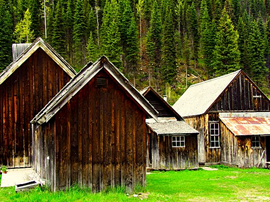Kentish ragstone
[edit] Introduction
Kentish ragstone is a building stone that has been used – both historically and currently – throughout South East England. It is a hard, medium grey, sandy limestone from the Cretaceous era (and so is a ‘young’ limestone) that is quarried in Kent from the Hythe Formation of the Lower Greensand group.
In appearance, it has a rough, course texture that is difficult to work, so even carving square blocks can be difficult. For this reason, it does not tend to be suited to fine stonework; consequently, it is sometimes used for infilling a wall that is faced with a ‘fairer’ stone. However, due to the scarcity of good stone in the South East, it has become a very familiar building material in Kent and the neighbouring counties.
[edit] Historical use
Historically, Kentish ragstone was quarried primarily around Maidstone, Kent, from where it could be easily shipped on barges down the River Medway, then carried up the Thames to places as far as Eton and Windsor.
The Romans used Kentish ragstone for the walls of Londinium. During the medieval period the material was in much demand in London for churches and engineering works such as river walls. It was also used on the Tower of London, Rochester Castle, the medieval Guildhall, London and Westminster Abbey, as well as numerous churches in Kent.
One of the most celebrated examples of Kentish ragstone is Knole House, near Sevenoaks, Kent, built in 1456, where the material is seen extensively for window surrounds, string courses, copings and finials, all demonstrating that it can achieve a good finish if carefully chosen.
Its use declined in 17th century London as brick and Portland stone gained favour.
Possibly due to its hard, uncoursed, irregularly bonded and rubble-like consistency, Kentish ragstone remained a favoured building stone for Victorian churches. However, the course, uneven texture may attract dirt which can mar the aesthetics.
Today, Kentish ragstone is still used in Kent as a vernacular material for building and repair work but its use in surrounding regions is generally limited due to the difficult processes involved and the variable nature of the material. As a result, it is sold by the tonne and can be used for gabion walling, as a general construction aggregate, and for resurfacing paths.
[edit] Related articles on Designing Buildings Wiki
- Choosing stone.
- Defects in stonework.
- Finding stone to conserve historic buildings.
- Inspecting stone sample panels.
- Limestone for building.
- Masonry.
- Modern Stonemasonry.
- Natural stone cladding.
- Natural stone.
- Portland Stone.
- Sourcing stone to repair Exeter Cathedral.
- Stone dressing.
- Tufa and tuff
- Types of stone.
IHBC NewsBlog
IHBC Context 183 Wellbeing and Heritage published
The issue explores issues at the intersection of heritage and wellbeing.
SAVE celebrates 50 years of campaigning 1975-2025
SAVE Britain’s Heritage has announced events across the country to celebrate bringing new life to remarkable buildings.
IHBC Annual School 2025 - Shrewsbury 12-14 June
Themed Heritage in Context – Value: Plan: Change, join in-person or online.
200th Anniversary Celebration of the Modern Railway Planned
The Stockton & Darlington Railway opened on September 27, 1825.
Competence Framework Launched for Sustainability in the Built Environment
The Construction Industry Council (CIC) and the Edge have jointly published the framework.
Historic England Launches Wellbeing Strategy for Heritage
Whether through visiting, volunteering, learning or creative practice, engaging with heritage can strengthen confidence, resilience, hope and social connections.
National Trust for Canada’s Review of 2024
Great Saves & Worst Losses Highlighted
IHBC's SelfStarter Website Undergoes Refresh
New updates and resources for emerging conservation professionals.
‘Behind the Scenes’ podcast on St. Pauls Cathedral Published
Experience the inside track on one of the world’s best known places of worship and visitor attractions.
National Audit Office (NAO) says Government building maintenance backlog is at least £49 billion
The public spending watchdog will need to consider the best way to manage its assets to bring property condition to a satisfactory level.















